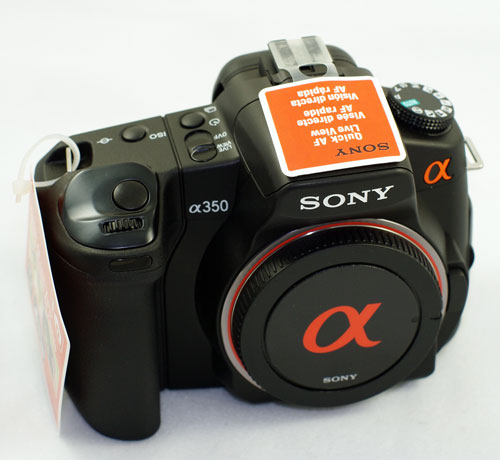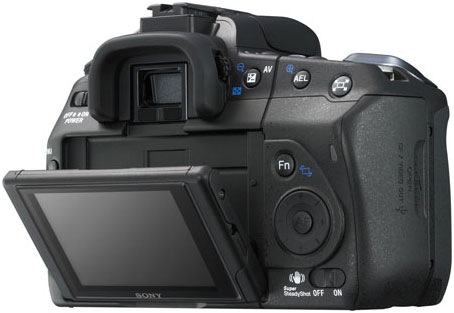Sony A350: Full-Time Live View at 14.2MP
by Wesley Fink on April 3, 2008 3:00 AM EST- Posted in
- Digital Camera
Features and Handling
Sony is used to playing in the large volume retail space where every trick used to gain visibility can result in higher sales.

This is very clear in the packaging theme for Sony DSLR cameras and accessories. No one will miss the bright orange and white (or bright orange and silver) that makes the Sony packages stand out.

The A350 body is on the small side, like the other Sony entry DSLR models, without the extreme smallness that seems to some a problem with the Canon XTi or Nikon D60/D40x. The new Canon XSi is a bit larger than the previous model to address size complaints and accommodate a 3.0" LCD. The Sony A350 is both a little wider (5.25" vs. 5.1") and taller (4.0" vs. 3.8") than the upsized XSi. Minolta pioneered body-integral image stabilization, and the evolved Sony Super Steady Shot is a feature on every Sony DSLR, along with auto sensor cleaning.
The top deck contains a single dial to adjust mode (full-auto, program, shutter-priority, and aperture-priority) and a wide selection of special scene programs such as portrait, sports, night, etc. On the opposite side of the viewfinder hump you will find a mechanical (no power required) Live View/OVF (Optical Viewfinder) switch, timer/drive mode button, and ISO button. The shutter release and shift/adjust dial are on top of the comfortable handgrip.

9-point auto-focus is featured on the A350. The layout and pattern is the same as the A200, A300, and earlier A100 suggesting it is the same AF module. The burst AF speeds on all models also support the conclusion that this is likely the same venerable AF module used in previous Minolta and Sony digital SLRs. Sony claims faster AF in the newest models, and that is likely the result of faster data processing in the supporting data processing modules in the DSLR. The prosumer A700 uses an updated and faster 11-point AF system. The A350 AF system is very competitive in its class and a big step up from the Olympus 510/410/420 and Nikon D60/D40x 3-point AF modules.


While the A350 is a bit larger than the Canon XSi, the LCD is 2.7" instead of the 3.0" LCD featured on the XSi. However, it is the only LCD in its class that is articulated, allowing an upward tilt as far as perpendicular for low-level shots and a down tilt to allow holding the camera above your head for crowd shots. These kinds of shooting situations require a contortionist on the usual DSLR and they are a great benefit for the capable and fast Sony Quick AF Live View. The LCD brightness is adjustable up and down, but it was still a challenge to read info on the LCD in bright sunlight. Perhaps some aftermarket LCD hood will improve LCD viewing.

The rear finds the on-off switch to the left of the viewfinder, which is typical of all the current Sony models. To the right of the viewfinder are the metering pattern/exposure compensation button, AEL (exposure lock)/zoom button, and the unique auto teleconverter. The teleconverter switch just takes advantage of the high-resolution sensor to give you instant 1.4x and 2x crops of the regular image. It does not add or interpolate pixels.
The main part of the a350's back is dominated by the 2.7" tilt screen, and the expected MENU, DISPlay, Delete (Trash Can), and Playback buttons to the left of the screen. To the right is the extremely useful Fn (function) button, which brings up the most commonly used adjustments to allow quick adjustments without searching through menus. The up/down/select multi-controller is used to navigate menus and the screen and a Super Steady Shot on/off switch complete the rear controls.
The sensors at the bottom of the viewfinder are the trademark Minolta "auto-on" when you bring the viewfinder toward your face in OVF mode. There is also a small knurled wheel to adjust viewfinder focus to match your eyesight. This former high-end feature is now making its way into almost all of today's DSLR cameras.
Handling
The A350 is an entry-level camera despite some high-end features like the 14.2MP sensor. As such, it is designed to be easy to use. Ours came out of the package setup at the factory for Live View mode with Super Steady Shot on. In general, Sony made the controls very easy to use and figure out. Sony tells us one complaint from buyers moving from point-and-shoot digital cameras to a digital SLR is that they are often overwhelmed by the controls of the DSLR. Point-and-Shoot users will find the A350 easy to use and familiar right out of the box.
Another editor at AnandTech ordered the A350 from SonyStyle as soon as he saw the specifications in our PMA reporting. He received his A350 last week and commented that the controls on the A350 were extremely easy to figure out and use. He said after 15 minutes he felt like he could figure out most everything on the camera and he was ready to "shoot like a Pro" with the A350. If other new users also find this kind of "instant comfort" with the A350, it will become a big seller.










113 Comments
View All Comments
steveChance - Tuesday, April 29, 2008 - link
[please disregard this post if this topic has been covered already in the readers' comments as I have not read all twelve pages of them]I find it odd that you would test cameras using printed matter as sample subject. Like digital images printed matter (esp. 4-color process) has its own errors that will (IMHO) negatively effect the photographic results.
Use a loupe to view at the actual item shown in the crops...
jcbenten - Friday, April 25, 2008 - link
Nice article. I presume I have come across this with all the corrections. I look forward to comparisons to the XSi, K200, and A300. I am "attempting" to purchase my first (D)SLR and I continue to out think myself. Your A350 crops came out much better than I anticipated. Maybe there is still life in the CCD.punchkin - Tuesday, April 8, 2008 - link
... before performing another "comparison".cputeq - Wednesday, April 9, 2008 - link
You should also consider the text of the review before making snide comments.The review indicated all camera white balance settings were set to Tungsten. If one camera or another has a warmer look than another, that's the "fault" of the camera.
The issue of the image comparisons was noise, not color accuracy.
Zak - Wednesday, April 9, 2008 - link
I'm not saying the review was bad or good, I can't care less for SONY's cameras, and I don't want to put down your efforts, but I think AnandTech is losing focus. Please return to your roots: computer stuff and leave the camera reviews to other established camera review sites that don't do computer stuff review;) When I come here I want to read about about computer stuff. If I want to read about cameras I go to DP Review, Steve's Cams, Digital Camera Resource, Fred Miranda, The Imaging Reource just to name a few. Honestly, I see at least 50% drop in number of interesting articles on AT. Oh, and the same goes for game reviews. XBox game reviews on AT? Please…Zak
MKFAGAN - Monday, April 7, 2008 - link
I was wondering why everyone is down playing the in camera zoom feature this is huge..The way I see it I have a 50mm 1.4 which is actually a 70mm with the 1.6 crop I press the button to get 1.4x zoom this gives me a 98 1.4 lens I press it again I get 2x zoom so I get a 140mm 1.4 thats huge It is like having 3 prime lenses in 1 so what if I lose a few MP This is big could you imagine a 135mm 2.8 with crop factor 216mm 2.8 press the button to 2x zoom I have a 432mm 2.8 this is a huge featureWesley Fink - Tuesday, April 8, 2008 - link
The auto-teleconverter is convenient, but it is really just a crop of the 14.2 megapixel image. You can do that by croppping images from any digital camera. I was also disappointed that the auto teleconverter does not work in Live View mode.In fact, there is no real zoom mode in Live View to assist in focusing, as I learned the hard way in trying to set critical focus for the resolution/noise crops. The tiny viewfinder and no zoom in LV made accurate manual focusing a real chore. While Sony's Live View is the fastest and most convenient LV we have tested, both the Pentax K20D and Olympus E-3 allow you to select an area to enlarge in LV and then magnify it (7X, 10X) for manual focusing - which does work real-time on both cameras. That made manual focusing MUCH easier for the test series on those two cameras.
haplo602 - Thursday, April 10, 2008 - link
Briliant Wesley ... THIS is that kind of information that should have been in the review !!!That's also what I meant in my earlier post. Camera handling and the little quirks that either get in the way or aid in actual shooting.
Maybe I missed the part in the review, but I do not recall you mentioning the auto-teleconverter. Also the LV limitation on focusing (coupled with the horrible viewfinder) are a critical point that should have been in the review.
retired hiker - Monday, April 7, 2008 - link
I have a problem with the title of your review. Tell me how I can Live View at 14.2MP. Certainly the tiny display on the camera can't give me that resolution.krakman - Saturday, April 5, 2008 - link
also they sell fer around 30$ on amazon.